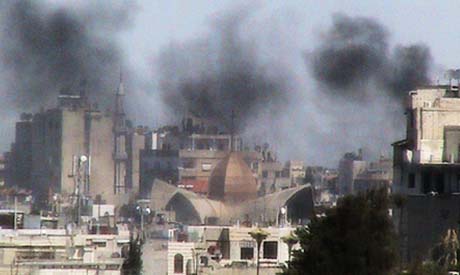
Smoke rises from the Bab Sabaa neighborhood of Homs. (Photo: Reuters)
With Damascus the political capital and the northern city of Aleppo the main commercial hub, Homs with its 1.6 million residents is a major industrial centre.
Homs province is the largest and most strategic in the country, lying on key trade routes near the borders with Lebanon and Iraq, and with its southwestern areas not far from Damascus.
A security official told AFP on Monday, after the army entered the rebel-held district of Khaldiyeh, that the military hoped to eliminate the last pockets of resistance in Homs and the nearby town of Qusayr by the end of the week to free up troops for battle zones in the north, such as Aleppo.
The regime of President Bashar al-Assad, which has repeatedly accused armed "terrorist" groups of fomenting the unrest that started in mid-March 2011, launched a large-scale offensive on the city on February 4.
Using tanks, helicopters, mortars, rockets and gunfire, troops pounded residential areas of Homs killing some 700 people, mainly civilians.
After weeks of siege the army launched a ground assault and on March 1 took control of the Baba Amr neighbourhood, a bastion of the rebel Free Syrian Army.
The attacks also cost the lives of American war reporter Marie Colvin and French photographer Remi Ochlik on February 22, when the building that served as a makeshift media centre in Homs was struck by a Syrian shell.
To the east and west of Homs are oil refineries and gas fields, a car assembly line for Iran's Khodro Company (IKPO) as well as a raft of other private industries.
Homs is also an important road junction, which sees transit goods arriving from the Mediterranean on their way to Iraq.
But it also sits on a faultline of sectarian tensions within Syria and is awash with weapons, making anti-regime protests in Homs particularly significant.
Mainly divided along confessional lines, Sunni, Alawite, Christian and mixed neighbourhoods co-exist uneasily.
Sunnis consider themselves to be the true natives of the city and never took kindly to the mass influx of Alawites -- members of a Shiite sect to which Assad also belongs -- to Homs and its surrounding districts since the late 1960s.
Alawites were received with a mixture of contempt and jealousy, because they received far more government and public positions than Sunnis.
Activists have accused the authorities of seeking to aggravate sectarian strife almost since the start of the uprising, pointing to a day in July, 2011 when some 30 people from different confessional groups were reportedly killed.
Paradoxically, Homs is home to Syria's first military academy, established by the French in 1932, which trained officers at the forefront of the coup that brought the Baath party to power in 1963, including Assad's late father, Hafez.
Short link: